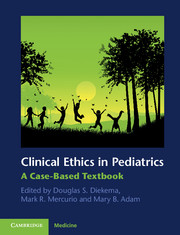Book contents
- Frontmatter
- Contents
- Contributors
- Preface
- Section 1 Core issues in clinical pediatric ethics
- Section 2 Ethical issues at the beginning of life: perinatology and neonatology
- 10 Maternal–fetal conflicts
- 11 Fetal intervention and fetal care centers
- 12 Ripped from the headlines: assisted reproductive technology and multiple births
- 13 Preimplantation and prenatal genetic testing for inherited diseases, dispositions, and traits
- 14 Decision-making in the delivery room
- 15 Withholding and withdrawing life-sustaining intervention from neonates
- 16 The role of quality of life assessments in neonatal care
- 17 Variations of practice in the care of extremely preterm infants
- Section 3 When a child dies: ethical issues at the end of life
- Section 4 Ethical issues posed by advances in medical technology and science
- Section 5 Children, public health, and justice
- Section 6 Special topics in pediatric ethics
- Index
- References
11 - Fetal intervention and fetal care centers
from Section 2 - Ethical issues at the beginning of life: perinatology and neonatology
Published online by Cambridge University Press: 07 October 2011
- Frontmatter
- Contents
- Contributors
- Preface
- Section 1 Core issues in clinical pediatric ethics
- Section 2 Ethical issues at the beginning of life: perinatology and neonatology
- 10 Maternal–fetal conflicts
- 11 Fetal intervention and fetal care centers
- 12 Ripped from the headlines: assisted reproductive technology and multiple births
- 13 Preimplantation and prenatal genetic testing for inherited diseases, dispositions, and traits
- 14 Decision-making in the delivery room
- 15 Withholding and withdrawing life-sustaining intervention from neonates
- 16 The role of quality of life assessments in neonatal care
- 17 Variations of practice in the care of extremely preterm infants
- Section 3 When a child dies: ethical issues at the end of life
- Section 4 Ethical issues posed by advances in medical technology and science
- Section 5 Children, public health, and justice
- Section 6 Special topics in pediatric ethics
- Index
- References
Summary
Introduction
Historically, promoting fetal well-being was not a separate endeavor from promoting maternal well-being. New imaging and sampling techniques now enhance our ability to help a woman help her fetus, and, when necessary, directly intervene with the fetus in the womb (Harrison, 2001). Some interventions are offered and recommended as preventive measures in obstetrical offices (i.e., prenatal folic acid), others are routinely provided in labor and delivery suites (i.e., antenatal antibiotics), still others are routine in perinatal specialty care (i.e., antiviral therapy). But with the development of fetal care centers, more invasive medical or surgical procedures, such as antiarrhythmics, an EXIT (ex-utero intrapartum therapy) procedure, or a skilled minimally invasive or open fetal surgery, have become possible. The difference between these newer more invasive procedures and the others seems to lie in the benefit/burden ratios to the fetus and pregnant woman. Three cases will be used to explore the ethical issues that arise from the fetal interventions performed in fetal care centers.
Case narrative 1: standard of care, potentially life-saving, chronic pediatric condition
Pam Smith is a 29-year-old, married, gravida 3 para 2 woman who otherwise has normal prenatal lab values, and has early, routine prenatal care. She has had two normal healthy pregnancies that resulted in two healthy girls, now aged 5 and 3 years. Pam and her husband are really hoping for a son with this pregnancy. At her first 18–20 week ultrasound, however, oligohydramnios was discovered, and she and her husband Bill were given the bad news that their male fetus might have a problem. They were referred to a perinatologist, who agreed with the initial ultrasound, and also found an enlarged bladder and hydronephrosis, both classic findings in a male fetus of a bladder outlet obstruction caused by posterior urethral valves. The couple are counseled about the possibility of referral to a local fetal care center for a vesico-amniotic shunt, which entails placing a catheter with one end in the bladder and the other in the amniotic cavity. This decompresses the bladder, bypassing the valves, and allows amniotic fluid to re-accumulate. The fetal care center staff counsel the Smiths that the vesico-amniotic shunting has been shown to prevent lung hypoplasia, but has not been proven to prevent renal disease. These children may require long-term peritoneal dialysis followed by renal transplant. Not performing the procedure will likely lead to newborn death from pulmonary hypoplasia.
- Type
- Chapter
- Information
- Clinical Ethics in PediatricsA Case-Based Textbook, pp. 57 - 62Publisher: Cambridge University PressPrint publication year: 2011



